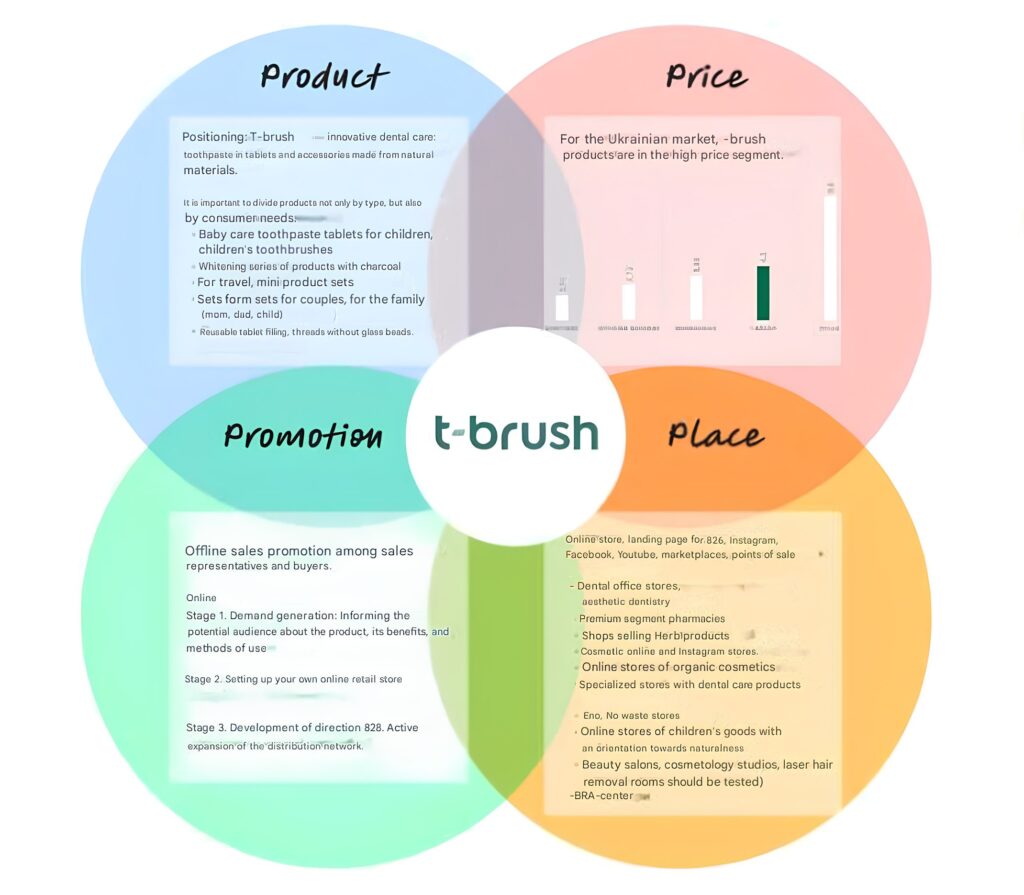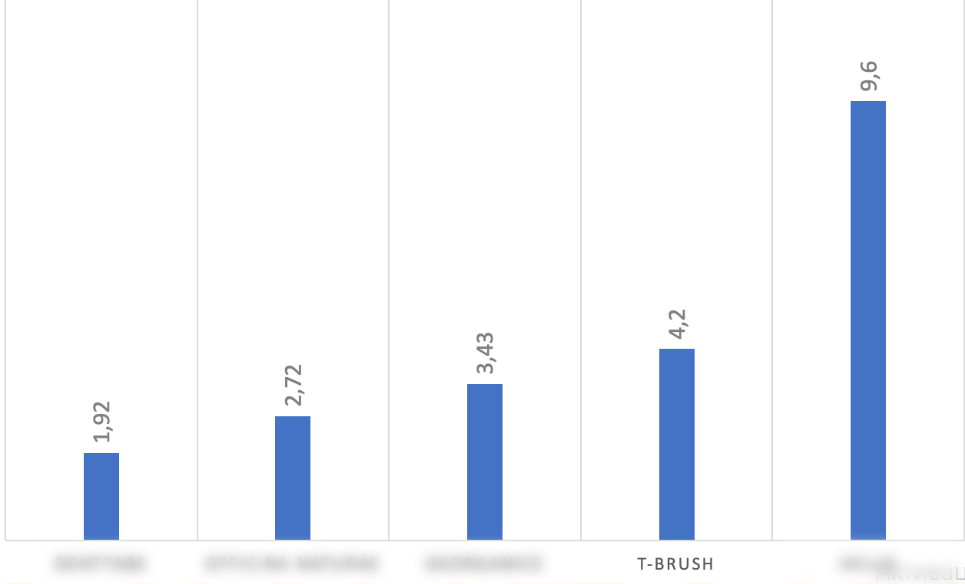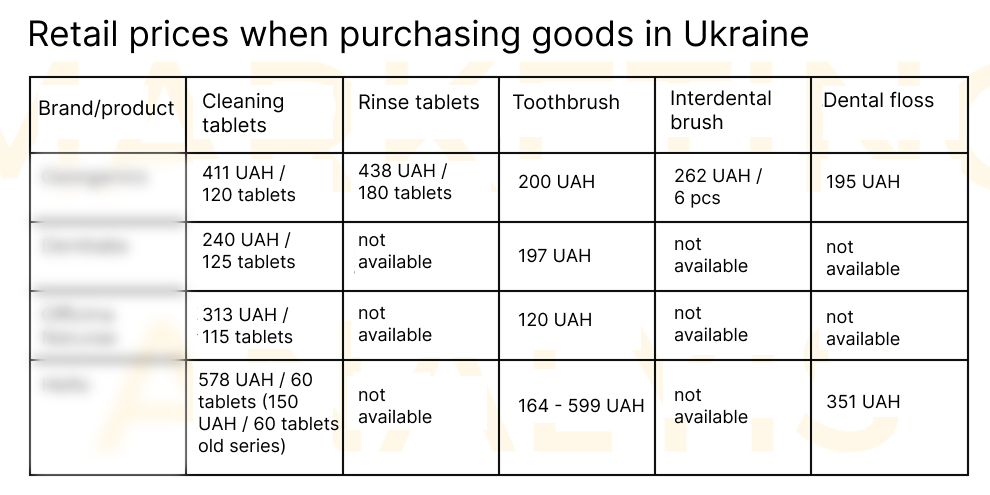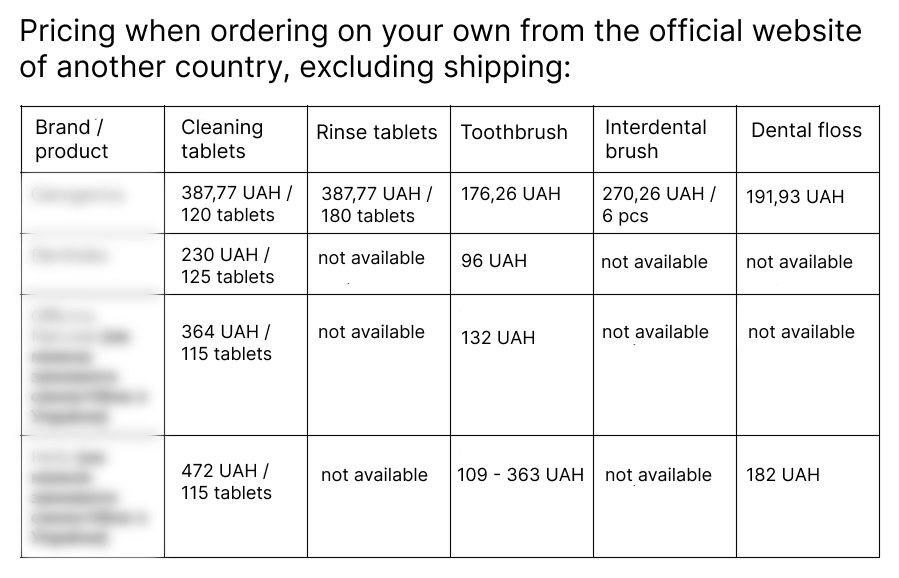Toothpaste. A simple thing that people use every day without even thinking about it. It’s in every bathroom, has been with us since childhood, and remains a constant part of our morning and evening rituals. We unscrew the tube, squeeze out a strip of toothpaste, brush our teeth and get on with our day. But what if we said that this mundane action could change everything?
When we were approached by the founders of T-brush, their request sounded like this:
“We want to change the habits of Ukrainians and make our toothpaste in tablets the new standard in oral care. We believe that we can build a business with sales of $300,000 in just one year.”
However, one question remained: how to convince Ukrainians to change their habits and choose something they hadn’t really thought about?
This is where our work began. We immersed ourselves in the analysis of the market, competitors, consumers and formed a marketing strategy.
| How long did it take to develop the strategy? | 120 hours, 4 working weeks |
| What is the composition of the marketing strategy development team? | Head of Marketing Team, Head of Content Team, Project Manager, Operational Marketer, Marketing Assistant, Content Marketer, Head of PPC Department, PPC Facebook Specialist. |
| How was the result of the work used? | Implementation on the client’s side. |
Shall we get to know each other?
T-brush is a Turkish eco-brand for dental care. The product range includes: toothpastes in tablets, toothbrushes, dental floss, bamboo toothbrush containers, interdental brushes, tongue cleaners, and mouthwash tablets.
The production facility is located in Istanbul and has a capacity of 10 million jars per month.
All ingredients are 100% natural: eco-friendly, vegan, and safe for the environment. Only glass containers are used, and all components are supplied from Europe and have the necessary licences.
The main advantage of the tablets is their precise dosage. Unlike traditional toothpaste, it is impossible to take too much or too little — one tablet is ideally designed for one use.
There are different lines: with and without fluoride, different flavours for everyone, and a children’s series. The products are approved by dentists, but it is important to understand that this is not a medical device, but a hygienic and cosmetic product designed for comfortable and healthy dental care on a daily basis.
Insight: if you are launching a new product that is supposed to change users’ habits, it may seem even stranger to them than toothpaste in tablets. The main question in this situation is how to find an audience that is ready to change their habits. And most importantly, what they will do it for.
The biggest advantages of the product:
- Natural product
- Aesthetic visual
- Better quality than regular toothpaste
- Convenient to take with you (travelling, nature, fishing)
- Healthy smile and clean environment
Is Ukraine ready for innovation in oral care?
We always start with one question: is there a place for this brand in this market? In the case of T-brush, the answer turned out to be much more interesting. We found an opportunity not just to enter a niche, but to become the ones who create it.
We analysed the toothpaste market in Ukraine, and the first thing that became apparent was that people are used to tubes. Colgate, Blend-a-med, Sensodyne, Elmex are part of the daily routine shaped by decades of advertising and convenience. But the market is changing. We researched global trends and saw that the market for toothpaste tablets is already moving forward: globally, it is growing by 6.2% annually.
It turned out that none of the brands that already offer toothpastes in tablets do so on a large scale. They are only available in niche eco-stores such as Ozero or Biotus, but not in supermarkets, large pharmacies, or on marketplaces with strong advertising.
How do consumers choose toothpaste?
Despite the growth prospects, the habit of using tube toothpaste has been formed over the years, and the transition to tablets requires a change in consumer mindset. According to the founder of the Bite brand, this process takes time — it requires educational campaigns, testing and explaining the benefits.
What is happening in the market where such products are already available?
+ Easy to use, environmentally friendly, portable, no plastic.
– Higher cost, the need to chew before brushing, an unusual format for consumers.
In addition, it is important to take into account the specifics of the audience:
✅ Travellers, military personnel, volunteers — appreciate compactness and convenience.
✅ Environmentally conscious people — willing to pay more if the product meets their principles.
✅ Mothers with children — they are attentive to the safety and naturalness of the composition.
Ukrainian market: a challenge or an opportunity?
The Ukrainian toothpaste market is dominated by large imported brands that invest heavily in advertising. That is why consumers focus on familiar names and do not always pay attention to innovations.
- Toothpaste is an essential commodity, so demand for it remains stable even in times of war.
- There is virtually no competition in the market for toothpaste tablets — only a few imported brands are available online, and there are almost no offline sales.
- Consumers learn about the product through advertising and a wide presence in retail, which is why creating demand should be the first step before entering the market on a large scale.
We have analysed the competitive environment and opportunities in depth and noticed that in Ukraine, toothpaste in tablets is almost not sold in supermarkets, and its few variants can be found only in niche eco-friendly stores or marketplaces.
The key threats are low consumer awareness, traditional format habits, complex logistics, and high competition from market giants.
Global trends show an ever-increasing need for eco-friendly products, so T-brush can become a leader in a new segment in Ukraine.
Perhaps now is the perfect time to start?
Who is already on the market and what are the opportunities for T-brush?
There is hardly any toothpaste in tablets on the Ukrainian market, which means that there is no clear leader in this niche. However, there are a few international brands that either sell this product through niche stores or are just testing this area.
We found out who is already operating in Ukraine and what these companies are doing. For example, one of our competitors entered the market through supermarkets (Watsons, EVA, ATB) and social media, even without having its own website.
We also studied the competitors’ social networks in detail: who works with bloggers, who focuses on dentists, who uses advertising, and who just waits for customers to find the product themselves. We found the weaknesses in their strategies and figured out how we could play ahead.
Analysis of entry points:
- How does import work?
- Are there any logistical difficulties (sea routes were blocked, delays at the border were 20+ days)?
- How are prices formed and why is the premium segment growing faster than the mass segment?
- How do distributors work and why do many people not see tablets as a promising product at all?
We put all these puzzle pieces together to create a clear picture.
What do we see behind the competition?
- Most brands do not conduct active marketing in Ukraine.
- All brands are sold only through niche stores or marketplaces (Rozetka, Ozero, Nowaste Shop, Make Up).
- Some competitors work through dentists, which is an opportunity for T-brush.
- Local importers and distributors do not yet see toothpaste in tablets as a separate niche.
That is, competition in terms of sales through supermarkets is minimal, but there are several brands already operating in the eco-store niche. However, none of them has an active promotion strategy in Ukraine.
To consolidate its strong market position and stay ahead of the competition, the brand should focus on several strategic areas. First of all, to take a leading position in the niche of “Toothpaste in tablets”. Currently, the market does not yet have a clear leader, which means that there is an opportunity to become the first to gain a foothold in the minds of consumers as the main brand in the category.
This can be achieved through active marketing, a recognisable brand and competent promotion in key channels.
Insight: just as Xerox once became a generic noun for all copiers, a company entering the market is one of the first to have the opportunity to conduct brand generalisation, when its own brand name becomes a common name for all similar products.
Another promising vector is to expand the B2B business through cooperation with hotels, clinics, and beauty salons. The brand can become the main supplier of eco-friendly hygiene products for businesses that care about customer comfort.
Analysing competitors’ content
Creating a content strategy that works is impossible without a thorough analysis of competitors, their strengths and weaknesses, target audience behaviour, and the effectiveness of various communication channels.
We analysed 5 competitors in detail and put all the data into a comparative table, and here is some of this information:
One of the competitors, immediately meets the user with its key idea — Zero Waste. Their website speaks for itself: laconic, eco-friendly, and functional. They make great use of a store locator to encourage users to buy products offline, and they offer a discount for subscribing to their newsletter. At the same time, their blog hasn’t been updated in over a year, which means they’re missing out on driving new organic traffic.
Competitors underestimate the power of content marketing, have weaknesses in website usability, and sometimes do not fully reveal the uniqueness of their products.
Insight: the strongest brands play the game of habit change. They don’t just say “we have a great product”, but demonstrate how their product changes lives.
When we look at all these puzzles together, we realise that we can create a high-quality conversion tool that will sell even when marketing activity is on hold. Support chat, automated emails after subscription, trust triggers, videos, comparisons, a strong brand story — these are the things that decide whether a person will buy a product or close the tab.
And now, knowing all these nuances, we can create a website that will work for the Ukrainian consumer.
This is an example of an integrated approach, where the analysis of customer behaviour, brand communications, and the capabilities of advertising tools form an action plan to achieve results.
We find the tools that work for your business!
Competitors’ pricing
We have researched competitors’ retail prices when buying goods in Ukraine and included the data in comparative tables:
“Mystery shopping” research
Live experience of interaction with competitors, which allows you to:
- Check the speed and quality of query processing. Who responds instantly and who ignores them? Do they keep in touch after the first contact?
- Understand how they build cooperation. Do they have standardized documents for partners? Do they have a flexible approach to communication?
- See if they have official distributors in Ukraine. If not, this is an additional window of opportunity for us.
- Find out what communication channels they use. We noticed that European brands mainly communicate through mail, while Ukrainian brands use messengers, which is an important factor in choosing a communication strategy.
What did the test show?
Three companies did not respond to the request at all, and two more responded only after a second request. This is a signal that they are either not interested in the Ukrainian market or have an inefficient system of communication with potential partners.
At the same time, the speed of response differed significantly between European and Ukrainian brands. While Europeans responded on average in two days, Ukrainian representatives responded much faster — up to several hours. This is an important detail that shows the expectations of the audience in Ukraine: here you can’t keep a client waiting.
We collect all the results — screenshots, notes, and conclusions — in a separate file, which we supplement with our own conclusions.
We help startups enter the market with confidence, and help businesses scale and improve their marketing
Positioning
We analyse our competitors not just as a list of companies, but as part of the market in which we need to find our unique place. It’s important to understand how competitors present themselves, what ideas they promote and what makes them special to customers.
When we first saw the Turkish positioning of “New Generation Toothpaste“, we imagined how the Ukrainian consumer would perceive it. We saw a picture of a person flipping through a feed, coming across an advert and reading this slogan. His first reaction: “What’s wrong with the old one?”
Insight: people are not looking for a revolution in dental care. They don’t wake up in the morning thinking: “Oh, I need to change something about the way I brush my teeth. They’ve been using regular tubes for years and don’t see it as a problem. Therefore, if we want the product to be talked about, we need to change our approach.
Our previous research helped us to understand what is really important for our audience: competitors, the market, and content:
- Environmental friendliness works, but only if it goes hand in hand with convenience.
- Naturalness is good, but only if it is proven, not just a nice word.
- Innovations are interesting, but they should solve a problem.
What should be the positioning of “toothpaste in a new way”:
T-brush is an innovative dental care product: toothpaste in tablets and accessories made of natural materials.
When a person meets a new product for daily use, you need to explain what it does quickly and, most importantly, accurately. The rest will be shaped by their own experience of interaction. It is impossible to convince a person to use something that is inconvenient for them on a daily basis. That’s why honesty and transparency are important.
After researching all the components, we moved on to formulating a strategy:
To enter the t-brush market, we need to work out the components of the marketing mix, which consist of 4 parts:

1. Product
After analysing the t-brush product range and possible target audiences, we divided the product into categories, creating a logic of perception. For children — children’s brushes and flavours, for travellers — travel kits, for eco-conscious people — minimalist reusable packaging. We don’t sell “something for everyone”, we speak to each consumer segment in the language of their needs.
| By Product Type | By Consumer Needs |
|
|
2.Price
We analysed the pricing policy by comparing the average price per 1 tablet of toothpaste on the Ukrainian market:

T-brush is in the premium segment, and it needs to be properly justified. That is why we have prepared a comparison with competitors, created a discount scheme for B2B partners and developed a loyalty system for customers.
3. Place
The market for dental and gum care products in Ukraine does not work on the same principle as in Europe. People rarely look for alternatives on their own — they need to be explained and shown why this product is worth their attention.
We have found the places where the product will receive the right attention and will be able to gain a foothold in the premium segment:
✅ Premium dental and aesthetic medicine stores — where people already trust brands and are willing to pay for quality.
✅ Cosmetic stores and premium pharmacy platforms — for people who take care of themselves..
✅ Eco-markets and no-waste stores — where “naturalness” has the greatest resonance.
✅ Spas, beauty salons and hotels — where people want to try something new without buying it right away.
✅ Online stores (MakeUp, Rozetka, Panama) — because this is where people look for similar products.
4.Promotion
To bring a new brand and product to the market, you need to build demand. So we thought about how to make people want to try the product. How? Promotion should be divided into offline and online.
The offline promotion strategy includes the following aspects:
- Promotion of sales among sales representatives: dentists, facility administrators, cosmetologists, etc.
- Promotion of sales among buyers.
The online promotion strategy includes the following stages:

Stage 1: generating demand, informing the potential audience about the product, its benefits, and methods of use.
- Social networks
- Working with micro-influencers
- Targeted advertising
- SEO and content marketing
- B2B promotion
- Informational “sowings” on third-party platforms
- Cooperation with hotels
Stage 2: launching your own online retail store
- Creating the right store structure
- Designing product cards
- Content marketing
- Email marketing
- Customer loyalty system
- Customer support for orders
- Ratings and reviews
- Building professional analytics.
Stage 3: development of the B2B direction, active expansion of the distribution network
- Creating a landing page on a website for B2B
- Lead generation for B2B
- Promotional materials
- Partner programme
- Active involvement in cooperation through managers
- Thematic events
If you want to understand in more detail how marketing affects the growth of a company, read our article “Marketing without illusions”.
Conclusions: what does a marketing strategy bring to a new brand?
A marketing strategy is a clear plan that combines positioning, communication, sales channels and demand-generating activities. A system that works for long-term results:
- Shapes demand.
People don’t buy what they don’t understand. We found that the niche for toothpaste in tablets has not yet been formed in Ukraine. Therefore, the strategy should primarily focus on educational content, explaining the benefits and changing consumer habits. - Makes the product available.
Even the best product will not be sold if it is impossible to find or buy. That’s why the strategy includes the right choice of sales channels: marketplaces, pharmacies, eco-stores, dental clinics, hotels and partner outlets. - Creates trust.
Consumers don’t change their habits just like that. They need to be given proof of quality: reviews, expert recommendations, explanations about the product’s naturalness and effectiveness. - Works as a system and prepares the brand for scaling.
The right strategy is the foundation for growth and entry into new segments. We have foreseen the possibility of expanding to the international market, increasing B2B business, and attracting affiliate programmes.
This is not a one-month strategy. It is an exit plan that builds the foundation for long-term success.






